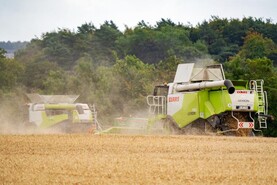Farm scientists need to replicate the communication model employed to sell the COVID-19 vaccine when seeking to disseminate the benefits of science in agriculture.
Researchers and public health specialists had communicated the benefits of the COVID-19 vaccine in an “outstanding” manner to the public, incoming Teagasc director Professor Frank O’Mara told the ASA conference.
He said agriculture faced a similar challenge in convincing consumers of the societal benefits that could accrue from adopting cutting edge technology such as gene-editing in plant and animal production.
'Great examples'
“I think we’ve seen great examples of good science communication in this country over the last 18 months from our colleagues in the medical field,” Prof O’Mara said.
“I think some of them [research scientists] were outstanding in the way they communicated around COVID. People accepted they had credibility because they knew what they were talking about,” he added.
The challenge for scientists in agriculture was to build a similar level of trust
The incoming director said the challenge for scientists in agriculture was to build a similar level of trust and give people the confidence to make their mind up on the basis of facts.
Using the development of blight resistant potatoes as an example, Prof O’Mara pointed out these crops needed just two pesticide sprays compared with the usual 13.
Similarly, he cited the animal welfare benefits of breeding cattle without horns, therefore negating the need for debudding or dishorning calves.
Dr Alison van Eenennaam from the University of California, Davis, likened the regulatory requirements on GM technology to those around research with “plutonium”.
Communication
She told the conference that the benefits of breeding technologies such as GMO and gene editing in terms of environmental sustainability were not being communicated in a fashion that generated positive public engagement.
Dr van Eenennaam claimed that an area equivalent to the entire cereal ground of California and Texas would be required to produce the additional output of corn and soya in the US that improved plant science had delivered since 1950.
The Californian scientist claimed the debate around science in agriculture was dominated by the “narrative of the negative” rather than the societal benefits being communicated.
Scientific evidence 'aligned with good communication' was the key to driving good policy
The Department of Agriculture’s chief inspector Bill Callanan said that scientific evidence “aligned with good communication” was the key to driving good policy and to securing public buy-in.
Mr Callanan insisted that science will be crucial in providing the empirical evidence that farming is minimising its environmental footprint, while continuing to supply quality food.
The Department official said the key actions in this process from an Irish perspective included the reduction of methane, cutting fertiliser usage and NO2 emissions and promoting carbon removal.
Incentives
Asked if the Government will incentivise these actions, Mr Callanan said the process would be driven by a combination of “market and Government supports”.
However, he said claims around carbon removals will have to be “supported by evidence” and will ultimately have to be validated.
Prof O’Mara said a mix of increased efficiency, better technology usage, carbon capture and changed land-use strategies will be required at farm level to meet the climate change challenge.
He said Teagasc’s Signpost programme, involving 100 farms, will form the main plank of the State agency’s strategy.






 This is a subscriber-only article
This is a subscriber-only article











SHARING OPTIONS: